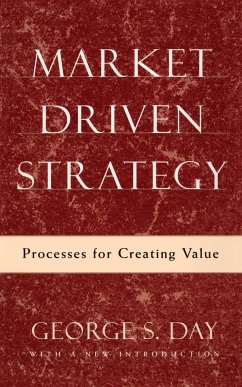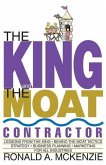George S. Day
Market Driven Strategy: Processes for Creating Value
24,99 €
inkl. MwSt.
Versandfertig in über 4 Wochen
George S. Day
Market Driven Strategy: Processes for Creating Value
- Broschiertes Buch
- Merkliste
- Auf die Merkliste
- Bewerten Bewerten
- Teilen
- Produkt teilen
- Produkterinnerung
- Produkterinnerung
Originally published: New York: Free Press; London: Collier Macmillan, c1990.
Andere Kunden interessierten sich auch für
![Taking Technology to Market Taking Technology to Market]() Roger Eli LevienTaking Technology to Market12,99 €
Roger Eli LevienTaking Technology to Market12,99 €![Market Yourself Through the Media Market Yourself Through the Media]() Bill PennMarket Yourself Through the Media50,99 €
Bill PennMarket Yourself Through the Media50,99 €![Marketing W/Student CD-ROM and Powerweb Marketing W/Student CD-ROM and Powerweb]() Michael J. EtzelMarketing W/Student CD-ROM and Powerweb141,99 €
Michael J. EtzelMarketing W/Student CD-ROM and Powerweb141,99 €![Wealth Creation Wealth Creation]() Muriel Wilson-JeanselmeWealth Creation76,99 €
Muriel Wilson-JeanselmeWealth Creation76,99 €![The King and the Moat Contractor The King and the Moat Contractor]() Ronald a. McKenzieThe King and the Moat Contractor23,99 €
Ronald a. McKenzieThe King and the Moat Contractor23,99 €![Marketing and Supply Chain Management Marketing and Supply Chain Management]() Dimitris FolinasMarketing and Supply Chain Management64,99 €
Dimitris FolinasMarketing and Supply Chain Management64,99 €![Business to Business Marketing Business to Business Marketing]() Wim G. BiemansBusiness to Business Marketing101,99 €
Wim G. BiemansBusiness to Business Marketing101,99 €-
-
-
Originally published: New York: Free Press; London: Collier Macmillan, c1990.
Hinweis: Dieser Artikel kann nur an eine deutsche Lieferadresse ausgeliefert werden.
Hinweis: Dieser Artikel kann nur an eine deutsche Lieferadresse ausgeliefert werden.
Produktdetails
- Produktdetails
- Verlag: Free Press
- Seitenzahl: 432
- Erscheinungstermin: 17. Januar 2015
- Englisch
- Abmessung: 231mm x 155mm x 30mm
- Gewicht: 476g
- ISBN-13: 9781501100178
- ISBN-10: 1501100173
- Artikelnr.: 41316059
- Verlag: Free Press
- Seitenzahl: 432
- Erscheinungstermin: 17. Januar 2015
- Englisch
- Abmessung: 231mm x 155mm x 30mm
- Gewicht: 476g
- ISBN-13: 9781501100178
- ISBN-10: 1501100173
- Artikelnr.: 41316059
George S Day
Contents
Introduction
Preface
PART ONE
Strategic Choices in Competitive Markets
1. Managing in Turbulent Markets
* Choices and Challenges in Turbulent Markets
* Successful Market Management
* When Strategy Matters
2. Strategies for Competing
* Business Definition
* Strategic Thrust
* Performance Objectives
* Attributes of a Sound Strategy
* The Payoff from a Sound Strategy
PART TWO
Processes for Developing Market-Driven Strategies
3. Making Strategic Decisions
* Approaches to Strategy Development
* Adaptive Planning: Integrating the Approaches
* Plans That Can Be Implemented
4. Adaptive Planning
* Situation Assessment
* Real-Time Issues Management
* Negotiating Objectives and Resources
* Completing the Planning Process
PART THREE
Assessing the Competitive Position
5. Understanding Competitive Markets: Their Structure and Attractiveness
* Defining the Market
* Finding Attractive Segments
* Market Attractiveness
* Choosing the Market Arena and Target Segment
6. Assessing Advantages
* The Concept of Competitive Advantage
* Customer-Oriented Assessments
* Competitor-Centered Assessments
* Integrated Assessments of Competitive Advantage
PART FOUR
Choosing Arenas and Advantages
7. Deciding How to Compete
* Strategies for Competing
* Strategies for Enhancing Customer Value
* Cost Competitive Strategies
* Changing the Competitive Strategy
8. Deciding Where to Compete: Focusing and Sustaining the Advantage
* Segmentation Focus Strategies
* Choosing the Scope of Market Coverage
* Sustaining the Advantage
* Defending the Advantage
* Lessons for Strategy
9. Gaining Access to Markets
* Channel Design Decisions
* The Turbulent Channel Environment
* Developing a Channel strategy
* Navigating the Turbulent Channel Environment
10. Responding to Global Markets
* Assessing the Extent of Globalization
* Choosing Strategies for Competing Globally
* Deciding How to Participate
* Implementing Global Strategies
* Meeting the Global Challenge
PART FIVE
Renewing the Strategy
11. Charting New Directions: Conditions for Successful Renewal
par
* Staying Close to the Market
* Setting the Strategic Direction
* Sticking to the Knitting
* Innovating under Time Pressure
* Ensuring Organizational Support
* The Conditions for Success
12. Setting the Growth Direction
* Growth Objectives
* Strategic Purpose
* Growth Path
* Method of Participation
* Toward a Strategic Guidance System
PART SIX
Issues in Implementing Market-Driven Strategies
13. Choosing Market Strategies
* The Process of Valuing Market Strategies
* Why Value Analysis Is Not Strategy Analysis
* Misleading Signals from Value Analysis
* Finding a Role for Value Analysis
14. Building a Market-Driven Organization: The Key to Competing Effectively
* Perspectives on Market-Driven Organizations
* Becoming Market-Driven
* Toward Market-Driven Strategies
Notes
Index
Introduction
Preface
PART ONE
Strategic Choices in Competitive Markets
1. Managing in Turbulent Markets
* Choices and Challenges in Turbulent Markets
* Successful Market Management
* When Strategy Matters
2. Strategies for Competing
* Business Definition
* Strategic Thrust
* Performance Objectives
* Attributes of a Sound Strategy
* The Payoff from a Sound Strategy
PART TWO
Processes for Developing Market-Driven Strategies
3. Making Strategic Decisions
* Approaches to Strategy Development
* Adaptive Planning: Integrating the Approaches
* Plans That Can Be Implemented
4. Adaptive Planning
* Situation Assessment
* Real-Time Issues Management
* Negotiating Objectives and Resources
* Completing the Planning Process
PART THREE
Assessing the Competitive Position
5. Understanding Competitive Markets: Their Structure and Attractiveness
* Defining the Market
* Finding Attractive Segments
* Market Attractiveness
* Choosing the Market Arena and Target Segment
6. Assessing Advantages
* The Concept of Competitive Advantage
* Customer-Oriented Assessments
* Competitor-Centered Assessments
* Integrated Assessments of Competitive Advantage
PART FOUR
Choosing Arenas and Advantages
7. Deciding How to Compete
* Strategies for Competing
* Strategies for Enhancing Customer Value
* Cost Competitive Strategies
* Changing the Competitive Strategy
8. Deciding Where to Compete: Focusing and Sustaining the Advantage
* Segmentation Focus Strategies
* Choosing the Scope of Market Coverage
* Sustaining the Advantage
* Defending the Advantage
* Lessons for Strategy
9. Gaining Access to Markets
* Channel Design Decisions
* The Turbulent Channel Environment
* Developing a Channel strategy
* Navigating the Turbulent Channel Environment
10. Responding to Global Markets
* Assessing the Extent of Globalization
* Choosing Strategies for Competing Globally
* Deciding How to Participate
* Implementing Global Strategies
* Meeting the Global Challenge
PART FIVE
Renewing the Strategy
11. Charting New Directions: Conditions for Successful Renewal
par
* Staying Close to the Market
* Setting the Strategic Direction
* Sticking to the Knitting
* Innovating under Time Pressure
* Ensuring Organizational Support
* The Conditions for Success
12. Setting the Growth Direction
* Growth Objectives
* Strategic Purpose
* Growth Path
* Method of Participation
* Toward a Strategic Guidance System
PART SIX
Issues in Implementing Market-Driven Strategies
13. Choosing Market Strategies
* The Process of Valuing Market Strategies
* Why Value Analysis Is Not Strategy Analysis
* Misleading Signals from Value Analysis
* Finding a Role for Value Analysis
14. Building a Market-Driven Organization: The Key to Competing Effectively
* Perspectives on Market-Driven Organizations
* Becoming Market-Driven
* Toward Market-Driven Strategies
Notes
Index
Contents
Introduction
Preface
PART ONE
Strategic Choices in Competitive Markets
1. Managing in Turbulent Markets
* Choices and Challenges in Turbulent Markets
* Successful Market Management
* When Strategy Matters
2. Strategies for Competing
* Business Definition
* Strategic Thrust
* Performance Objectives
* Attributes of a Sound Strategy
* The Payoff from a Sound Strategy
PART TWO
Processes for Developing Market-Driven Strategies
3. Making Strategic Decisions
* Approaches to Strategy Development
* Adaptive Planning: Integrating the Approaches
* Plans That Can Be Implemented
4. Adaptive Planning
* Situation Assessment
* Real-Time Issues Management
* Negotiating Objectives and Resources
* Completing the Planning Process
PART THREE
Assessing the Competitive Position
5. Understanding Competitive Markets: Their Structure and Attractiveness
* Defining the Market
* Finding Attractive Segments
* Market Attractiveness
* Choosing the Market Arena and Target Segment
6. Assessing Advantages
* The Concept of Competitive Advantage
* Customer-Oriented Assessments
* Competitor-Centered Assessments
* Integrated Assessments of Competitive Advantage
PART FOUR
Choosing Arenas and Advantages
7. Deciding How to Compete
* Strategies for Competing
* Strategies for Enhancing Customer Value
* Cost Competitive Strategies
* Changing the Competitive Strategy
8. Deciding Where to Compete: Focusing and Sustaining the Advantage
* Segmentation Focus Strategies
* Choosing the Scope of Market Coverage
* Sustaining the Advantage
* Defending the Advantage
* Lessons for Strategy
9. Gaining Access to Markets
* Channel Design Decisions
* The Turbulent Channel Environment
* Developing a Channel strategy
* Navigating the Turbulent Channel Environment
10. Responding to Global Markets
* Assessing the Extent of Globalization
* Choosing Strategies for Competing Globally
* Deciding How to Participate
* Implementing Global Strategies
* Meeting the Global Challenge
PART FIVE
Renewing the Strategy
11. Charting New Directions: Conditions for Successful Renewal
par
* Staying Close to the Market
* Setting the Strategic Direction
* Sticking to the Knitting
* Innovating under Time Pressure
* Ensuring Organizational Support
* The Conditions for Success
12. Setting the Growth Direction
* Growth Objectives
* Strategic Purpose
* Growth Path
* Method of Participation
* Toward a Strategic Guidance System
PART SIX
Issues in Implementing Market-Driven Strategies
13. Choosing Market Strategies
* The Process of Valuing Market Strategies
* Why Value Analysis Is Not Strategy Analysis
* Misleading Signals from Value Analysis
* Finding a Role for Value Analysis
14. Building a Market-Driven Organization: The Key to Competing Effectively
* Perspectives on Market-Driven Organizations
* Becoming Market-Driven
* Toward Market-Driven Strategies
Notes
Index
Introduction
Preface
PART ONE
Strategic Choices in Competitive Markets
1. Managing in Turbulent Markets
* Choices and Challenges in Turbulent Markets
* Successful Market Management
* When Strategy Matters
2. Strategies for Competing
* Business Definition
* Strategic Thrust
* Performance Objectives
* Attributes of a Sound Strategy
* The Payoff from a Sound Strategy
PART TWO
Processes for Developing Market-Driven Strategies
3. Making Strategic Decisions
* Approaches to Strategy Development
* Adaptive Planning: Integrating the Approaches
* Plans That Can Be Implemented
4. Adaptive Planning
* Situation Assessment
* Real-Time Issues Management
* Negotiating Objectives and Resources
* Completing the Planning Process
PART THREE
Assessing the Competitive Position
5. Understanding Competitive Markets: Their Structure and Attractiveness
* Defining the Market
* Finding Attractive Segments
* Market Attractiveness
* Choosing the Market Arena and Target Segment
6. Assessing Advantages
* The Concept of Competitive Advantage
* Customer-Oriented Assessments
* Competitor-Centered Assessments
* Integrated Assessments of Competitive Advantage
PART FOUR
Choosing Arenas and Advantages
7. Deciding How to Compete
* Strategies for Competing
* Strategies for Enhancing Customer Value
* Cost Competitive Strategies
* Changing the Competitive Strategy
8. Deciding Where to Compete: Focusing and Sustaining the Advantage
* Segmentation Focus Strategies
* Choosing the Scope of Market Coverage
* Sustaining the Advantage
* Defending the Advantage
* Lessons for Strategy
9. Gaining Access to Markets
* Channel Design Decisions
* The Turbulent Channel Environment
* Developing a Channel strategy
* Navigating the Turbulent Channel Environment
10. Responding to Global Markets
* Assessing the Extent of Globalization
* Choosing Strategies for Competing Globally
* Deciding How to Participate
* Implementing Global Strategies
* Meeting the Global Challenge
PART FIVE
Renewing the Strategy
11. Charting New Directions: Conditions for Successful Renewal
par
* Staying Close to the Market
* Setting the Strategic Direction
* Sticking to the Knitting
* Innovating under Time Pressure
* Ensuring Organizational Support
* The Conditions for Success
12. Setting the Growth Direction
* Growth Objectives
* Strategic Purpose
* Growth Path
* Method of Participation
* Toward a Strategic Guidance System
PART SIX
Issues in Implementing Market-Driven Strategies
13. Choosing Market Strategies
* The Process of Valuing Market Strategies
* Why Value Analysis Is Not Strategy Analysis
* Misleading Signals from Value Analysis
* Finding a Role for Value Analysis
14. Building a Market-Driven Organization: The Key to Competing Effectively
* Perspectives on Market-Driven Organizations
* Becoming Market-Driven
* Toward Market-Driven Strategies
Notes
Index







